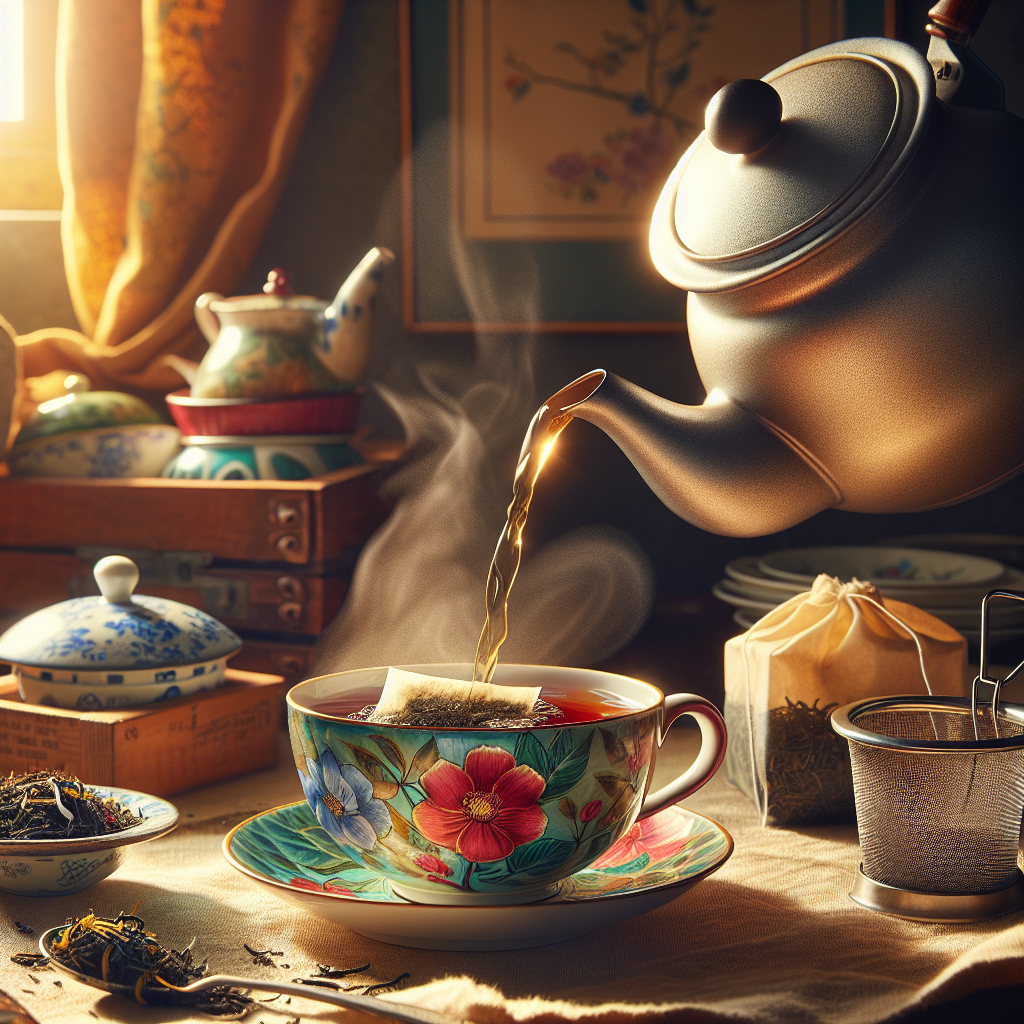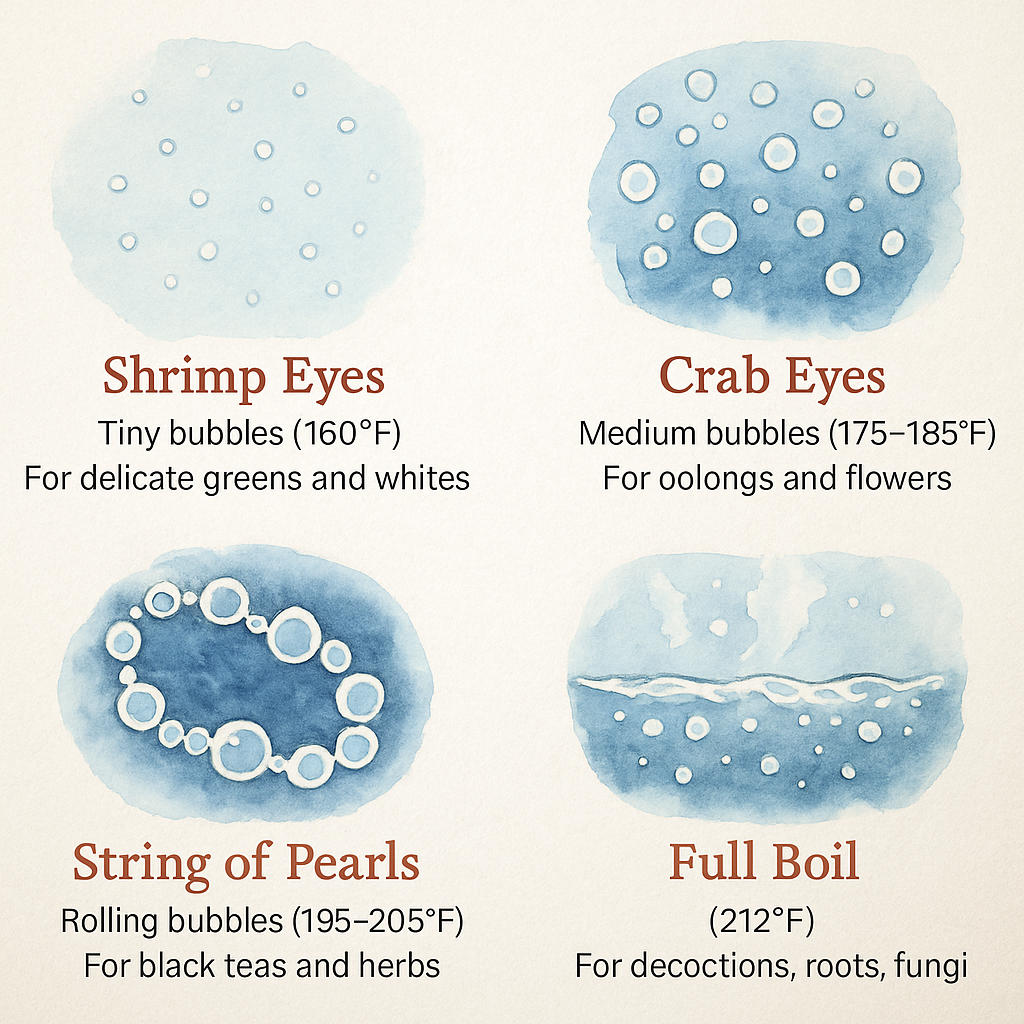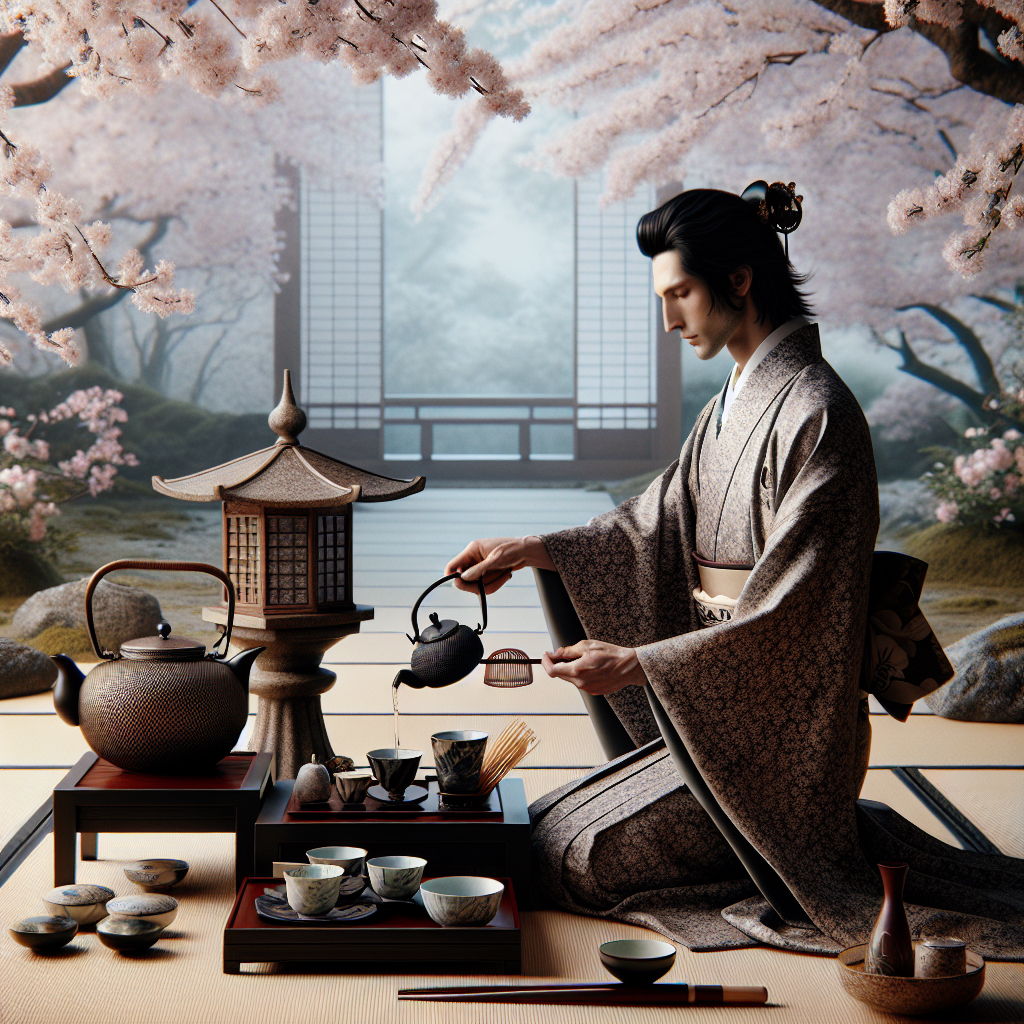The Secret Science of Tea Brewing: How Water Temperature Affects Flavor, Caffeine, and Healing Power
Most of us reach for a cup of tea to wake up, wind down, or find calm. But few realize that the secret to how tea makes you feel lies not in the leaf—but in the temperature of the water.
There’s an old saying in Chinese tea culture: “The leaf reveals its spirit only to water that listens.”
Modern science is now confirming what Traditional Chinese Medicine (TCM) practitioners knew centuries ago — temperature changes everything.
 Every cup of tea is far more than leaves meeting hot water—it’s a living chemical conversation. The moment water touches the leaf, thousands of compounds awaken, dissolve, and interact. Each group of molecules responds to heat differently, and that response determines whether your tea nourishes the body or shocks the palate.
Every cup of tea is far more than leaves meeting hot water—it’s a living chemical conversation. The moment water touches the leaf, thousands of compounds awaken, dissolve, and interact. Each group of molecules responds to heat differently, and that response determines whether your tea nourishes the body or shocks the palate.
At the gentlest temperatures, around 160–175°F (70–80°C), the water coaxes out amino acids like L-theanine—the same compound responsible for tea’s calm, meditative focus. These lower temperatures also preserve delicate volatile oils that give floral and green teas their soft aroma and sweetness.
As the temperature climbs toward 185–205°F (85–96°C), the conversation changes. Catechins and polyphenols—the antioxidant powerhouses of tea—begin to dissolve more readily, giving the brew body, structure, and that familiar astringent “bite.” This is also when caffeine extraction accelerates, producing a brisker, more energizing cup.
Push the heat to a full boil, and you enter the territory of roots, barks, and medicinal herbs. Here, polysaccharides and saponins—larger, heavier molecules found in herbs like astragalus, licorice, and reishi—need that extra energy to break free. These compounds are what give herbal decoctions their smooth, “brothy” texture and tonic strength.
But balance is everything. Brew too hot, and those same antioxidants can degrade, the oils evaporate, and bitterness overwhelms. Brew too cool, and extraction stalls—your tea may smell pleasant but deliver little depth or benefit.
Incredibly, a difference of only 10–15°F (5–8°C) can flip the entire sensory and energetic profile of your tea—from calming to stimulating, from sweet and silky to sharp and tannic. This subtle temperature shift is why skilled brewers and traditional herbalists treat the act of brewing as both art and alchemy—a precise balance of fire, water, and intention that transforms simple leaves into liquid medicine.
In this guide, we’ll explore:
-
The science of extraction temperature
-
The TCM wisdom behind warming and cooling teas
-
Step-by-step brewing temperatures by herb and tea type
-
Folklore, visuals, and real-world results
-
And how to transform your tea from “just a drink” into a healing ritual
Why Temperature Matters to You
-
Better flavor, less bitterness
-
Stronger aroma and energy balance
-
Greater extraction of beneficial compounds
-
Improved digestion and calm according to TCM
Section 1: The Science Behind Water Temperature and Healing Power
Different plant compounds are unlocked at distinct heat thresholds, and this temperature dance is what transforms tea brewing into both a science and a sensory ritual. Each class of compound—whether aromatic, nutritive, or tonic—reacts to heat in its own way, shaping not only the tea’s flavor and color, but also its energetic and therapeutic qualities.
Think of temperature as a key and each compound as a different lock:
-
Cool water opens the door to fragrance and clarity.
-
Moderate heat releases antioxidants and gentle stimulation.
-
Hotter water unlocks deep nourishment and herbal strength.
When you understand this interplay, you can intentionally shape your tea experience—choosing calm or vitality, lightness or depth—simply by adjusting the temperature. In this way, brewing tea becomes an act of conscious creation, where science supports tradition, and every degree of heat reveals a new layer of healing potential.
The tea shifts from pale jade to deep amber as the temperature rises—each hue signaling a different harmony of taste and energy.
| Compound Group | Found In | Best Temperature | Function |
|---|---|---|---|
| Amino Acids (L-Theanine) | Green tea, oolong | 150–175°F (65–80°C) | Calming, sweet flavor, smooth body |
| Polyphenols (Catechins/Theaflavins) | Green, black, pu-erh teas | 175–205°F (80–96°C) | Antioxidant, structure, color |
| Caffeine | All tea types | 190–212°F (88–100°C) | Stimulating, energy boost |
| Volatile Oils | Flowers, aromatic herbs | 160–185°F (70–85°C) | Aroma, relaxation, digestive comfort |
| Polysaccharides/Saponins | Roots, barks, fungi | 200–212°F (93–100°C, simmer) | Strengthening, immune support, “brothy” feel |
Why it matters:
Temperature determines which molecules dissolve and which are destroyed. A slightly cooler brew protects calming amino acids; a hotter one pulls out more antioxidants.
Section 2: Brewing Temperatures by Tea Type (Camellia sinensis)
| Tea Type | Water Temp | Time | What It Unlocks |
|---|---|---|---|
| Green (Sencha, Longjing) | 160–175°F | 1–3 min | Preserves L-theanine for calm focus; avoids bitterness. |
| White (Bai Mudan, Silver Needle) | 175–185°F | 2–4 min | Protects floral sweetness; ideal for sensitive stomachs. |
| Oolong (Tieguanyin, Dancong) | 185–205°F | 1–3 min | Balanced extraction of aroma and catechins. |
| Black (Dianhong, Assam) | 200–212°F | 2–4 min | Fully develops caffeine and polyphenols. |
| Pu-erh (Sheng/Shou) | 200–212°F | 10–20s or 3–5 min | Rinsing and multiple short infusions enhance digestibility. |
Pro Insight: Lowering your temperature by just 10°F can shift your tea from sharp and bitter to smooth and sweet.
Section 3: Herbal Tea Temperature by Category (Roots, Leaves, Flowers)
| Herbal Category | Examples | Method | Ideal Temp & Time |
|---|---|---|---|
| Leaves | Mint, lemongrass, mulberry | Infusion | 175–190°F (5–10 min) |
| Flowers | Chrysanthemum, chamomile, honeysuckle | Covered infusion | 170–185°F (5–10 min) |
| Fruits/Peels | Goji, hawthorn, tangerine peel | Infusion or gentle simmer | 190–205°F (10–20 min) |
| Roots/Barks | Astragalus, burdock, licorice, cinnamon | Decoction (simmer) | Light simmer 20–30 min |
| Fungi | Reishi, turkey tail | Decoction | Gentle simmer 30–60 min |
Tip: Start with roots, barks, or fungi — simmer for 20–30 minutes — then add delicate leaves and flowers at the end to preserve aroma.
Section 4: The Ancient Art of Gauging Heat

Long before thermometers, tea masters relied on visual cues — poetic, precise, and still relevant:
-
“Shrimp Eyes” → Tiny bubbles (160°F): for delicate greens and whites
-
“Crab Eyes” → Medium bubbles (175–185°F): for oolongs and flowers
-
“String of Pearls” → Rolling bubbles (195–205°F): for black teas and herbs
-
Full Boil (212°F) → For decoctions, roots, fungi
Japanese Sencha Tradition: Cooling boiled water in a yuzamashi (cooling bowl) preserves the umami.
TCM Wisdom: Overly hot drinks can injure “Spleen Qi,” while overly cold ones dampen digestive fire — balance is harmony.
Section 5: Practical Brewing Methods (No Thermometer Needed)
Boil-and-Rest Method
-
Boil water, uncover the kettle
-
Wait 1 min = ~200°F
-
2–3 min = ~185°F
-
5 min = ~175°F
Two-Cup Cool Method
Pour hot water into one mug, then another — each transfer drops ~5–10°F.
Altitude & Water Quality Tips:
-
Higher altitudes = lower boiling point; brew longer instead of hotter.
-
Filtered or spring water enhances flavor — avoid chlorinated water.
-
Clay retains heat longer; glass cools faster (perfect for greens).
Section 6: Choose Your Goal → Match the Brew
Experience the Difference in Every Cup.
Try brewing with lab-tested teas and herbs from 1st Chinese Herbs—pure, potent, and crafted for every temperature range.
Shop Premium Teas & Herbs →
| Goal | Ideal Herb or Tea | Temperature | Why It Works |
|---|---|---|---|
| Calm Clarity (Focus) | Green or oolong | 170°F | Preserves L-theanine & aroma, mild caffeine. |
| Evening Comfort | Chrysanthemum + Goji | 185°F | Floral oils + gentle sweetness = relaxation. |
| Deep Nourishment | Astragalus + Licorice | Simmer 25–30 min | Extracts immune polysaccharides. |
| Aroma & Refreshment | Peppermint leaf | 180°F | Captures menthol oils without bitterness. |
 Section 7: Folklore, Ritual, and Storytelling
Section 7: Folklore, Ritual, and Storytelling
In ancient China, tea was considered both medicine and meditation.
The scholar Lu Yu, author of The Classic of Tea (Cha Jing), wrote that “water is the mother of tea; the art lies in the fire.”
-
Monks in Tang Dynasty temples used specific water temperatures to calm the spirit before meditation.
-
Japanese tea ceremonies cool water intentionally to slow the mind.
-
In TCM, herbs are matched to temperature and element — cooling teas (chrysanthemum, mint) for summer heat; warming decoctions (ginger, cinnamon) for winter cold.
Tea isn’t just chemistry — it’s character, patience, and presence.
Tea Brewing Mistakes vs Fixes
| Common Mistake | Result | Simple Fix |
|---|---|---|
| Boiling green tea | Bitter, dry taste | Cool water to 170°F |
| Underheating oolong | Weak, flat flavor | Raise to 190°F |
| Over-simmering herbs | Lost aroma | Cover pot, shorten time |
Love this guide? Share it with a fellow tea lover! Sign Up for our Herbal Insights Newsletter
Section 8: Modern Science Confirms Ancient Wisdom
Scientific research backs what TCM masters practiced intuitively:
-
Polyphenol yield increases up to 200°F, but antioxidant stability drops above that (PubMed: 30107890).
-
Lower temperatures (160–175°F) preserve more L-theanine, supporting relaxation (PubMed: 32484171).
-
Volatile oils like linalool and menthol evaporate above 190°F, reducing aroma and therapeutic properties.
When brewing herbs for function, you’re not just making a drink — you’re conducting a controlled extraction.
Section 9: What Our Customers Say
“I used to pour boiling water over my green tea and could barely tolerate the bitterness. Dropping the temperature to 170°F changed everything—now it’s smooth, sweet, and calming. I actually crave it every afternoon.”
— L.M., Oregon“I always thought chamomile was bland until I stopped boiling it. At 180°F, the aroma opens up like a garden after rain—soft, floral, and comforting. It’s my favorite evening ritual now.”
— S.J., Washington“Astragalus never seemed to do much when I brewed it quickly. Then I learned to simmer it for 30 minutes. The result? A rich, golden broth that feels deeply nourishing—like warmth spreading from the inside out.”
— R.K., Texas
Section 10: Troubleshooting & Pro Tips
-
Bitter taste? Lower the temperature by 10°F or steep less.
-
Weak flavor? Slightly hotter water or longer steep.
-
No aroma? Cover your cup.
-
Using mixed herbs? Simmer roots first, add leaves later.
-
Want to experiment? Try a temperature flight — brew the same tea at 3 temperatures and taste the difference.
Tea Trivia — How Well Do You Know Your Brew?
1. When brewing green tea, what surprising change happens if you use boiling water (212°F)?
A) It becomes sweeter and richer in flavor
B) It turns bitter and loses its calming amino acids
C) It releases more aroma and floral oils
D) It tastes exactly the same at any temperature
✅ Answer: B — It turns bitter and loses its calming L-theanine.
2. Which type of tea actually needs near-boiling water (200–212°F) to unlock its full flavor and strength?
A) White tea
B) Green tea
C) Black or Pu-erh tea
D) Jasmine tea
✅ Answer: C — Black and Pu-erh teas thrive at hotter temperatures for a bold, full-bodied cup.
3. In traditional Chinese tea brewing, what do the poetic terms “shrimp eyes” and “crab eyes” describe?
A) Ancient tea leaves
B) Stages of boiling water
C) Tea color changes
D) Brewing vessels
✅ Answer: B — They refer to the different bubble stages used to judge water temperature before thermometers existed.
4. Which delicate herbs reveal their best aroma and healing properties around 180°F (82°C)?
A) Ginger and cinnamon
B) Astragalus and burdock
C) Chrysanthemum, chamomile, and honeysuckle
D) Ginseng and licorice
✅ Answer: C — These flowers release their fragrance beautifully at gentle heat levels.
5. According to Traditional Chinese Medicine, why are scalding-hot drinks discouraged?
A) They dull taste perception
B) They reduce caffeine absorption
C) They weaken the Spleen and Stomach Qi
D) They cause too much sweating
✅ Answer: C — Overly hot drinks can disrupt internal balance by harming the body’s digestive “Qi” energy.
Final Thought
Tea brewing isn’t just a recipe — it’s a relationship between the elements.
Every time you heat the water, measure the leaves, and pause before pouring, you’re engaging in a quiet dialogue with nature itself. Each temperature shift changes the outcome: a few degrees cooler can reveal sweetness and calm; a few degrees hotter can awaken depth, energy, and strength.
The beauty of tea lies in its responsiveness — it mirrors the brewer. When you rush, the brew becomes sharp. When you’re patient, it unfolds gently. This is why true tea preparation is often described as a form of meditation: it draws you into the present moment, teaching balance, awareness, and respect for process.
When water meets leaf in harmony, chemistry becomes art. The molecules rearrange, aromas bloom, and colors deepen — not through force, but through cooperation. What emerges is more than a drink; it’s liquid medicine, a reminder that healing can be simple, slow, and beautiful.
So the next time you brew a cup, don’t just make tea — make space.
Listen to the sound of the pour. Watch the leaves unfurl. Feel the warmth in your hands.
Because within that mindful ritual, you’re not only steeping leaves — you’re steeping peace, presence, and meaning into every sip.
Related Links
-
What Body Type Are You?
-
5 Excellent Reasons To Use Herbs
-
Discover Reishi Mushrooms
-
10 Vital Medicinal Herbs That Work (Free Ebook)
Author Bio
Written by Sarah Johnson, M.S. in Holistic Healing
Written by Sarah Johnson, M.S. in Holistic Healing and founder of 1st Chinese Herbs. Sarah has over 25 years of experience in Traditional Chinese Medicine and herbal education. Her goal is to bridge ancient wisdom with modern science through trusted, lab-tested herbs and educational guides.
“Lab-Tested,” “GMP Certified,” and “Trusted Since 1994” above or below the CTA.
Originally published in 2025. Updated regularly with new brewing research and TCM insights.
References:
. Temperature Impact on Catechins and Polyphenols
-
Astill, C., et al. Factors Affecting the Caffeine and Polyphenol Contents of Black and Green Tea Infusions. Journal of Agricultural and Food Chemistry, 2001. https://pubmed.ncbi.nlm.nih.gov/11170594/
-
Liang, Y., et al. Influence of Green Tea Manufacturing Conditions on the Polyphenol and Caffeine Contents of Green Tea Infusions. Food Chemistry, 2003. https://doi.org/10.1016/S0308-8146(02)00469-5
-
Vuong, Q. V., et al. The Effects of Extraction Conditions on Phenolic Compounds and Antioxidant Activity in Tea. Food Chemistry, 2011. https://pubmed.ncbi.nlm.nih.gov/23194511/
Summary: These studies confirm that temperature and steeping time greatly influence the concentration of catechins, caffeine, and antioxidant capacity. Exceeding 185°F (85°C) can increase bitterness and reduce delicate antioxidant stability.
2. Extraction of Polysaccharides from Roots and Medicinal Herbs
-
Zhao, H., et al. Optimization of Extraction Conditions for Polysaccharides from Astragalus Membranaceus and Their Antioxidant Activity. Carbohydrate Polymers, 2006. https://pubmed.ncbi.nlm.nih.gov/16677740/
-
Guo, L., et al. Extraction, Purification, and Biological Activities of Polysaccharides from Medicinal Herbs. International Journal of Biological Macromolecules, 2019. https://doi.org/10.1016/j.ijbiomac.2019.06.036
-
Li, X., et al. Effect of Water Temperature and Extraction Time on the Yield and Structure of Polysaccharides from Licorice Root. Journal of Food Science, 2020. https://doi.org/10.1111/1750-3841.15126
Summary: Polysaccharides from roots such as Astragalus and Licorice require near-boiling water or gentle simmering (200–212°F) for 20–30 minutes to maximize yield and maintain viscosity and immunomodulating potential.
3. Volatile Oil Stability in Herbal Teas and Flowers
-
Wang, L. F., et al. Influence of Temperature on the Volatile Constituents and Antioxidant Activity of Chamomile Infusions. Food Research International, 2008. https://doi.org/10.1016/j.foodres.2008.03.007
-
Chen, Y., et al. Effect of Heat Treatment on the Aroma Constituents of Chrysanthemum Flower Tea. LWT – Food Science and Technology, 2015. https://doi.org/10.1016/j.lwt.2014.10.042
-
Yuan, W., et al. Impact of Brewing Temperature on Aroma Release and Volatile Composition of Green Tea. Journal of Food Science, 2012. https://pubmed.ncbi.nlm.nih.gov/22958088/
Summary: Volatile oils responsible for aroma and calming effects (e.g., chamomile, chrysanthemum, mint) are heat-sensitive. Brewing above ~185°F can cause these compounds to evaporate, leading to loss of fragrance and therapeutic benefit.
